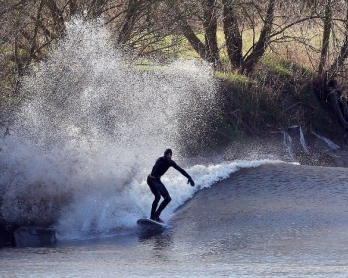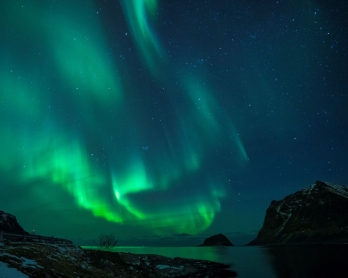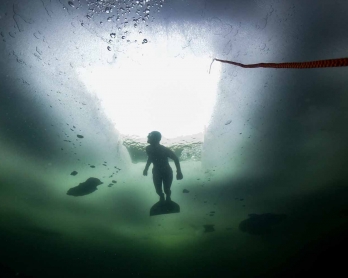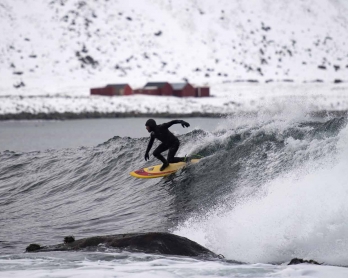Crazy in the North
Staumnes, Norway -- There is a certain Nordic spirit that affects people living in Scandinavia, especially in its northernmost reaches. The crazier the idea, the less likely you’ll give up pursuing it. Take the ice surfboard as a case in point.
 Frozen seaweed is seen on a surfboard made of ice at the Delp surfing spot, near Straumnes, in the Lofoten Islands, over the Arctic Circle on February 18, 2019. (AFP / Olivier Morin)
Frozen seaweed is seen on a surfboard made of ice at the Delp surfing spot, near Straumnes, in the Lofoten Islands, over the Arctic Circle on February 18, 2019. (AFP / Olivier Morin)The people who hang around surfing at Unstad, Norway, and environs are a special bunch. They surf in the dead of winter, way above the Arctic Circle, when the air can get as chilly as minus 10 Celsius (which can feel like minus 25 with the windchill). A surfing and a cold enthusiast myself, I have been photographing them for five years. And this year, they threw a new twist into the mix.
 (AFP / Olivier Morin)
(AFP / Olivier Morin)Several of the guys who are Unstad and Lofoten regulars decided to try to make a surfboard out of ice. And why not? It’s never been done before. They’re in a place where there is ice 10 months out of the year. Why not try to make a board out of it and see what happens?
 Norway's Inge Tamburaci Wegge check on the ice pack, at a fish factory in Svolvaer, in the Lofoten Islands, over the Arctic Circle, on February 16, 2019. (AFP / Olivier Morin)
Norway's Inge Tamburaci Wegge check on the ice pack, at a fish factory in Svolvaer, in the Lofoten Islands, over the Arctic Circle, on February 16, 2019. (AFP / Olivier Morin)Plus they wanted to push the ecology spirit of Scandinavia to the max. It sounded like a great way to have some fun. And there was a certain poetic spirit to it all -- as the surfboard melts, the surf returns to the water. Like “ashes to ashes, dust to dust,” but in this case it’s “water to water.” Without the morbid, sad connotations of a funeral service.
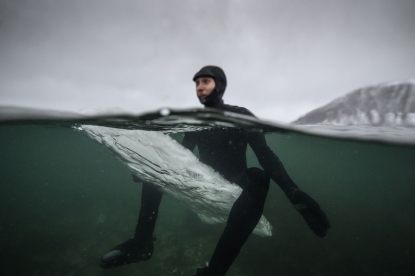 Swedish surfer Pontus Hallin waits for waves as he sits on his melting ice surfboard at the Delp surfing spot, near Straumnes, in the Lofoten Islands, over the Arctic Circle on February 18, 2019. (AFP / Olivier Morin)
Swedish surfer Pontus Hallin waits for waves as he sits on his melting ice surfboard at the Delp surfing spot, near Straumnes, in the Lofoten Islands, over the Arctic Circle on February 18, 2019. (AFP / Olivier Morin)And so ten of them -- six surfers and four of their friends -- went to work. First they cut ice chunks out of frozen lakes. But that didn't work. So they made molds out of plastic and wood. They filled the molds with fresh water (frozen fresh water is much stronger than frozen salt water) and a bit of seaweed to cut down on the slippage factor. They also added other things, just for fun.
 A cod's head is set up for decoration in an empty custom made tank along with seaweeds used as grip, before water is filled, in a fishing factory in Svolvaer, in the Lofoten Islands, over the Arctic Circle, on February 16, 2019. (AFP / Olivier Morin)
A cod's head is set up for decoration in an empty custom made tank along with seaweeds used as grip, before water is filled, in a fishing factory in Svolvaer, in the Lofoten Islands, over the Arctic Circle, on February 16, 2019. (AFP / Olivier Morin)Then they left the boards inside a fishery in a room where it was minus 25 Celsius for two days. And then they took them to the waves.
 Three-person job -- surfers lug a surfboard made of ice to the water at the Delp surfing spot, near Straumnes, in the Lofoten Islands, over the Arctic Circle on February 18, 2019. (AFP / Olivier Morin)
Three-person job -- surfers lug a surfboard made of ice to the water at the Delp surfing spot, near Straumnes, in the Lofoten Islands, over the Arctic Circle on February 18, 2019. (AFP / Olivier Morin)They spent four days trying out the boards, hauling the 70-kilogram contraptions to the water.
 (AFP / Olivier Morin)
(AFP / Olivier Morin)And have reached several conclusions.
 Norwegian Ice artist Cathinka poses with a surfboard made of ice, on the Delp surf spot, near Straumnes, in the Lofoten Islands, over the Arctic Circle, on February 18, 2019. (AFP / Olivier Morin)
Norwegian Ice artist Cathinka poses with a surfboard made of ice, on the Delp surf spot, near Straumnes, in the Lofoten Islands, over the Arctic Circle, on February 18, 2019. (AFP / Olivier Morin)The board lasts about 30 minutes in the ocean, where the water is about 3 degrees Celsius, before it all melts away.
 Swedish surfer Pontus Hallin stands on a rock as he holds a piece of his iced surfboard almost completely melted at the Delp surfing spot, near Straumnes, in the Lofoten Islands, over the Arctic Circle on February 19, 2019. (AFP / Olivier Morin)
Swedish surfer Pontus Hallin stands on a rock as he holds a piece of his iced surfboard almost completely melted at the Delp surfing spot, near Straumnes, in the Lofoten Islands, over the Arctic Circle on February 19, 2019. (AFP / Olivier Morin)Out of those 30 minutes, there are only about five during which the board is at an optimal shape for surfing. The trick is catching a good enough wave during those precise five minutes. The waves need to be strong -- not large, but strong. To get enough speed, you need a few guys actually pushing the board in the water, instead of the lone surfer just paddling. The reason is both the size and weight of the board and because the waves around here are wind waves, which aren’t as powerful as swells.
 Swedish surfers Pontus Hallin and Lisa Blom attempt to take off with a surfboard made of ice at the Delp surfing spot, near Straumnes, in the Lofoten Islands, over the Arctic Circle on February 19, 2019. (AFP / Olivier Morin)
Swedish surfers Pontus Hallin and Lisa Blom attempt to take off with a surfboard made of ice at the Delp surfing spot, near Straumnes, in the Lofoten Islands, over the Arctic Circle on February 19, 2019. (AFP / Olivier Morin)This type of surfing can be much more dangerous than surfing with regular boards -- if you fall and get hit on the head with a 60-70-kilo piece of ice, that can do some damage and hurt.
 Swedish surfer Pontus Hallin, 30 (R) and Mattias Hornquist, 42, shape a board out of ice on the Delp surfing sport, near Straumnes, in the Lofoten Islands, over the Arctic Circle on February 17, 2019. (AFP / Olivier Morin)
Swedish surfer Pontus Hallin, 30 (R) and Mattias Hornquist, 42, shape a board out of ice on the Delp surfing sport, near Straumnes, in the Lofoten Islands, over the Arctic Circle on February 17, 2019. (AFP / Olivier Morin)The one definite conclusion after four days of trial and error is that it can absolutely be done. They will make the necessary modifications and they will return until they it works (Hopefully after a bit of help from some friends).
And so will I, determined to catch that moment.
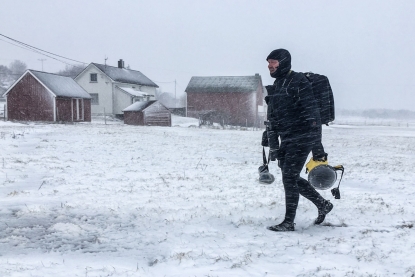 The author with his equipment walks out of the water. (Photo courtesy of Olivier Morin)
The author with his equipment walks out of the water. (Photo courtesy of Olivier Morin)Because that’s what crazy Nordic people do. And we’ll have a lot of fun trying.
This blog was written with Yana Dlugy in Paris.
 (AFP / Olivier Morin)
(AFP / Olivier Morin)



